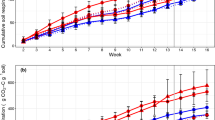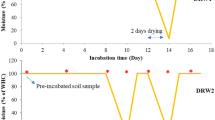Abstract
Drying and rewetting is a frequent physiological stress for soil microbial communities; a stress that is predicted to grow more influential with future climate change. We investigated the effect of repeated drying–rewetting cycles on bacterial (leucine incorporation) and fungal (acetate in ergosterol incorporation) growth, on the biomass concentration and composition (PLFA), and on the soil respiration. Using different plant material amendments, we generated soils with different initial fungal:bacterial compositions that we exposed to 6–10 repetitions of a drying–rewetting cycle. Drying–rewetting decreased bacterial growth while fungal growth remained unaffected, resulting in an elevated fungal:bacterial growth ratio. This effect was found irrespective of the initial fungal:bacterial biomass ratio. Many drying–rewetting cycles did not, however, affect the fungal:bacterial growth ratio compared to few cycles. The biomass response of the microbial community differed from the growth response, with fungal and total biomass only being slightly negatively affected by the repeated drying–rewetting. The discrepancy between growth- and biomass-based assessments underscores that microbial responses to perturbations might previously have been misrepresented with biomass-based assessments. In light of this, many aspects of environmental microbial ecology may need to be revisited with attention to what measure of the microbial community is relevant to study.





Similar content being viewed by others
References
Anderson JPE, Domsch KH (1978) Physiological method for quantitative measurement of microbial biomass in soils. Soil Biol Biochem 10:215–221
Bååth E (1994) Measurement of protein synthesis by soil bacterial assemblages with the leucine incorporation technique. Biol Fertil Soils 17:147–153
Bååth E (2001) Estimation of fungal growth rates using 14C-acetate incorporation into ergosterol. Soil Biol Biochem 33:2011–2018
Bååth E, Anderson TH (2003) Comparison of soil fungal/bacterial ratios in a pH gradient using physiological and PLFA-based techniques. Soil Biol Biochem 35:955–963
Bååth E, Pettersson M, Söderberg KH (2001) Adaptation of a rapid and economical microcentrifugation method to measure thymidine and leucine incorporation by soil bacteria. Soil Biol Biochem 33:1571–1574
Birch HF (1958) The effect of soil drying on humus decomposition and nitrogen. Plant Soil 10:9–30
Bloem J, de Ruiter PC, Koopman GJ, Lebbing G, Brussaard L (1992) Microbial numbers and activity in dried and rewetted arable soil under integrated and conventional management. Soil Biol Biochem 24:655–665
Butterly CR, Bünemann EK, McNeill AM, Baldock JA, Marschner P (2009) Carbon pulses but not phosphorus pulses are related to decreases in microbial biomass during repeated drying and rewetting of soils. Soil Biol Biochem 41:1406–1416
Consentino D, Chenu C, Bissonnais YL (2006) Aggregate stability and microbial community dynamics under drying–rewetting cycles in a silt loam soil. Soil Biol Biochem 38:1053–2062
Denef K, Six J, Paustian K, Merckx R (2001) Importance of macroaggregate dynamics in controlling soil carbon stabilization: short-term effects of physical disturbance induced by dry–wet cycles. Soil Biol Biochem 33:2145–2153
Fierer N, Schimel JP (2002) Effects of drying–rewetting frequency on soil carbon and nitrogen transformations. Soil Biol Biochem 34:777–787
Fierer N, Schimel JP (2003) A proposed mechanism for the pulse in carbon dioxide commonly observed following the rapid rewetting of a dry soil. Soil Sci Soc Am J 67:798–805
Fierer N, Schimel JP, Holden PA (2003) Influence of drying–rewetting frequency on soil bacterial community structure. Microb Ecol 45:63–71
Frostegård Å, Tunlid A, Bååth E (1993) Phospholipid fatty-acid composition, biomass, and activity of microbial communities from two soil types experimentally exposed to different heavy-metals. Appl Environ Microbiol 59:3605–3617
Frostegård Å, Bååth E (1996) The use of phospholipid fatty acid analysis to estimate bacterial and fungal biomass in soil. Biol Fertil Soils 22:59–65
Gordon H, Haygarth PM, Bardgett RD (2008) Drying and rewetting effects on soil microbial community composition and nutrient leaching. Soil Biol Biochem 40:302–311
Hamer U, Unger M, Makeschin F (2007) Impact of air-drying and rewetting on PLFA profiles of soil microbial communities. J Plant Nutr Soil Sci 170:259–264
Harris RF (1981) Effect of water potential on microbial growth and activity. In: Parr JF, Gardner WR, Elliott LF (eds) Water potential relations in soil microbiology. American Society of Agronomy, Madison, WI, USA, pp 23–95
Huntington TG (2006) Evidence for intensification of the global water cycle: review and synthesis. J Hydrol 319:83–95
Iovieno P, Bååth E (2008) Effect of drying and rewetting on bacterial growth rates in soil. FEMS Microbiol Ecol 65:400–407
Joergensen RG (2000) Ergosterol and microbial biomass in the rhizosphere of grassland soils. Soil Biol Biochem 32:647–652
Kemmitt SJ, Lanyon CV, Waite IS, Wen Q, Addiscott TM, Bird NRA, O'Donnell AG, Brookes PC (2008) Mineralization of native soil organic matter is not regulated by the size, activity or composition of the soil microbial biomass—a new perspective. Soil Biol Biochem 40:61–73
Kirchman D, K’Nees E, Hodson R (1985) Leucine incorporation and its potential as a measure of protein-synthesis by bacteria in natural aquatic systems. Appl Environ Microbiol 49:599–607
Kirschbaum MUF (1995) The temperature dependence of soil organic matter decomposition, and the effect of global warming on soil organic C storage. Soil Biol Biochem 27:753–760
Kirschbaum MUF (2000) Will changes in soil organic carbon act as a positive or negative feedback on global warming? Biogeochemistry 48:21–51
Marxsen J, Zoppini A, Wilczek S (2009) Microbial communities in streambed sediments recovering from desiccation. FEMS Microbiol Ecol 71:374–386
Mikha MM, Rice CW, Milliken GA (2005) Carbon and nitrogen mineralization as affected by drying and wetting cycles. Soil Biol Biochem 37:339–347
Milly PCD, Wetherald RT, Dunne KA, Delworth TL (2002) Increasing risk of great floods on a changing climate. Nature 415:514–517
Newell SY, Fallon RD (1991) Toward a method for measuring instantaneous fungal growth rates in field samples. Ecology 72:1547–1559
Nilsson LO, Bååth E, Falkengren-Grerup U, Wallander H (2007) Growth of ectomycorrhizal mycelia and composition of soil microbial communities in oak forest soils along a nitrogen deposition gradient. Oecologia 153:375–384
Pennanen T, Fritze H, Vanhala P, Kiikkila O, Neuvonen S, Bååth E (1998) Structure of a microbial community in soil after prolonged addition of low levels of simulated acid rain. Appl Environ Microbiol 64:2173–2180
Pietikäinen J, Pettersson M, Bååth E (2005) Comparison of temperature effects on soil respiration and bacterial and fungal growth rates. FEMS Microbiol Ecol 52:49–58
Ranneklev S, Bååth E (2003) Use of phospholipid fatty acids to detect previous self-heating events in stored peat. Appl Environ Microbiol 69:3532–3539
Rousk J, Bååth E (2007) Fungal and bacterial growth in soil with plant materials of different C/N ratios. FEMS Microbiol Ecol 62:258–267
Rousk J, Aldén Demoling L, Bååth E (2008) Examining the fungal and bacterial niche overlap using selective inhibitors in soil. FEMS Microbiol Ecol 63:350–358
Rousk J, Brookes PC, Bååth E (2009) Contrasting soil pH effects on fungal and bacterial growth suggest functional redundancy in carbon mineralisation. Appl Environ Microbiol 75:1589–1596
Rousk J, Brookes PC, Bååth E (2010) Investigating the mechanisms for the opposing pH relationships of fungal and bacterial growth in soil. Soil Biol Biochem 42:926–934
Ruzicka S, Edgerton D, Norman M, Hill T (2000) The utility of ergosterol as a bioindicator of fungi in temperate soils. Soil Biol Biochem 32:989–1005
Schimel JP, Scott WJ, Killham K (1989) Changes in cytoplasmic carbon and nitrogen pools in a soil bacterium and a fungus in response to salt stress. Appl Environ Microbiol 55:1635–1637
Schimel JP, Balser TC, Wallenstein M (2007) Microbial stress-response physiology and its implications for ecosystem function. Ecology 86:1386–1394
Steenwerth KL, Jackson LE, Calderón FJ, Scow KM, Rolston DE (2005) Response of microbial community composition and activity in agricultural and grassland soils after a simulated rainfall. Soil Biol Biochem 37:2249–2262
Van Gestel M, Merckx R, Vlassak K (1993) Microbial biomass responses to soil drying and rewetting: the fate of fast- and slow-growing microorganisms in soils from different climates. Soil Biol Biochem 25:109–123
Waksman SA, Tenney FG, Stevens KR (1928) The role of microorganisms in the transformation of organic matter in forest soils. Ecology 9:126–144
Waksman SA, Gerretsen FC (1931) Influence of temperature and moisture upon the nature and extent of decomposition of plant residues by microorganisms. Ecology 12:33–60
Williams MA (2007) Response of microbial communities to water stress in irrigated and drought-prone tallgrass prairie soils. Soil Biol Biochem 39:2750–2757
Wu J, Brookes PC (2005) The proportional mineralisation of microbial biomass and organic matter caused by air-drying and rewetting of a grassland soil. Soil Biol Biochem 37:507–515
Xiang SR, Doyle A, Holden PA, Schimel JP (2008) Drying and rewetting effects on C and N mineralization and microbial activity in surface and subsurface California grassland soils. Soil Biol Biochem 40:2281–2289
Acknowledgements
We thank Prof. D.L. Jones for helpful comments on the manuscript. AZ was supported by a grant from the Erasmus Mundus programme, and JR and EB by grants from the Swedish Research Council (VR).
Author information
Authors and Affiliations
Corresponding author
Rights and permissions
About this article
Cite this article
Bapiri, A., Bååth, E. & Rousk, J. Drying–Rewetting Cycles Affect Fungal and Bacterial Growth Differently in an Arable Soil. Microb Ecol 60, 419–428 (2010). https://doi.org/10.1007/s00248-010-9723-5
Received:
Accepted:
Published:
Issue Date:
DOI: https://doi.org/10.1007/s00248-010-9723-5




